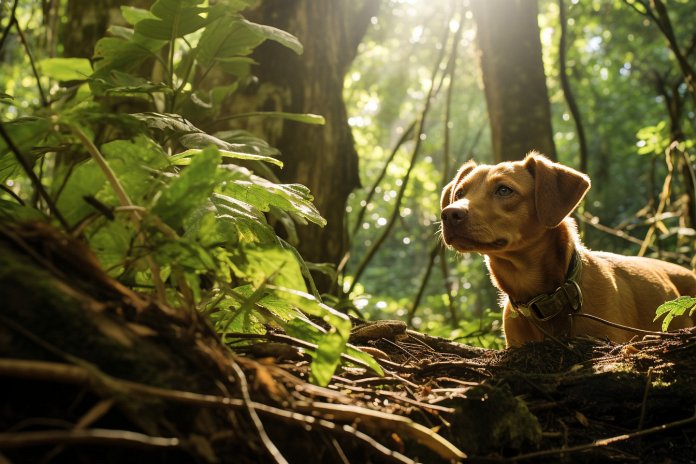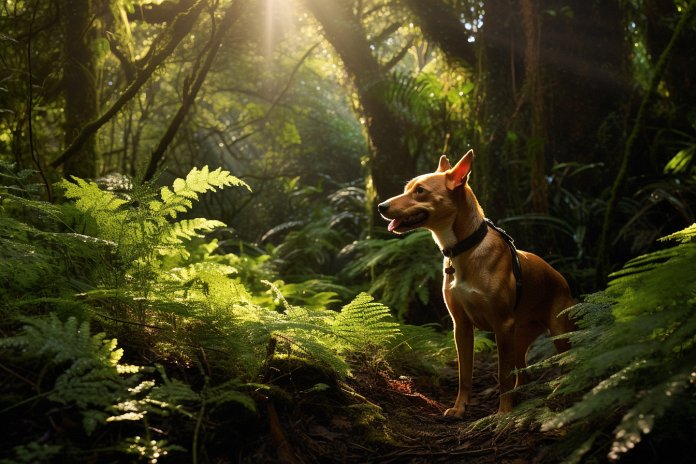
Dogs have an incredible sense of smell, which is forty times larger than ours despite their smaller brain size. They can detect termites underground, rats in tunnels, and snakes hiding in bushes. Dogs are often curious about snakes and are prone to snake bites on their face or nose as they attempt to investigate the snake’s scent.
Signs That Your Dog Has Sensed a Snake
Dogs are naturally curious and use their walks to explore and smell their surroundings. They may show signs of curiosity and increased sniffing in areas where snakes may be hiding. Snakes are more active during the spring and summer months, and some emit warning signs such as hissing or rattling. Dogs may also be attracted to the bad odor or unique sounds produced by certain snakes.
Body Language
Signs that your dog has sensed a snake include growling, scratching, sniffing, a raised tail, and perked ears. Other signs may include whining, focused attention on a particular spot, and excited behavior.
History of Dogs Sensing Snakes
Dogs have a natural protective instinct towards their owners and families. There are numerous stories of dogs saving people, especially children, from snake encounters. These encounters often occur when the snake’s camouflage allows it to go unnoticed, but the dog senses the danger and acts to protect their loved ones.
The Science of Dogs Sensing Snakes
Scientists have studied the canine sense of smell and have discovered that dogs have a special chamber in their nasal system that collects scent particles. Dogs also have an organ called Jacobson’s Organ, which allows them to taste smells. This unique combination makes dogs highly skilled at recognizing and remembering scents in their environment.
Training Dogs to Sense Snakes
Obedience training is crucial for dogs that may encounter snakes. Commands such as “leave it” or “stay” can help prevent a dog from approaching a snake. Desensitization or aversion training can also be used to train dogs to avoid snakes, but it is recommended to seek professional assistance for this type of training. Labradors have been trained to detect pythons in the Everglades, showcasing their impressive abilities.
Conclusion
Dogs possess an extraordinary sense of smell that allows them to detect snakes and other hidden dangers. Recognizing the signs that your dog has sensed a snake and providing proper training can help keep them safe. Dogs have a long history of protecting their owners from snakes, demonstrating their unwavering loyalty and courage.
“Trust your dog’s nose – they can sense snakes before you even see them.”

Tips & Things to Know
1️⃣ Be aware of the signs that your dog has sensed a snake. Look for signs of curiosity, extra sniffing, and intense focus on a specific spot. Also, pay attention to your dog’s body language, such as growling, scratching, and a tail and ears up.
2️⃣ Understand the history and instincts of dogs sensing snakes. Dogs have a natural protective instinct and have been known to save families from snake encounters. Their sense of smell is highly developed, allowing them to detect snakes from a distance. However, dogs may not always heed warning signs from snakes, so it’s important to be cautious.
3️⃣ Consider training your dog to sense and avoid snakes. Obedience training is essential, teaching commands like “leave it” or “stay” to ensure your dog listens to you in potentially dangerous situations. Desensitizing or aversion training may also be an option, especially if you live in an area with a high snake population. However, it’s recommended to seek professional assistance for this type of training.
Frequently Asked Questions, Answered ✅
1. What are some signs that my dog has sensed a snake?
– Some signs include curiosity, extra sniffing in a specific area, whining or barking to alert you, and intense focus on one spot.
2. How do dogs protect their families from snakes?
– Dogs have a natural protective instinct towards their owners and families. They can sense the presence of snakes through their heightened sense of smell and may exhibit behaviors such as growling, scratching, or sniffing to alert their owners.
3. How do dogs sense snakes?
– Dogs have a highly developed sense of smell, with their olfactory system being forty times larger than that of humans. They can detect the scent of snakes, even if the snakes emit warning signs or bad odors. Dogs may also hear the hissing or slithering sounds of snakes in the grass.
4. What is the science behind dogs sensing snakes?
– Dogs have a specialized chamber in their nasal system that can collect scent particles, allowing them to retain and analyze smells. They also have an organ called Jacobson’s Organ, which enables them to taste smells. Dogs have a memory for smells and become adept at recognizing and interpreting scents in their environment.
5. Can dogs be trained to sense snakes?
– Yes, dogs can be trained to sense snakes. Obedience training is essential to ensure that dogs obey commands when encountering snakes. Desensitizing or aversion training can also be done with the help of experts or behaviorists, although it may involve shock collars or intense tactics. Some breeds, like Labradors, have been trained to detect the presence of snakes, such as pythons in the Everglades, to help solve ecological issues.